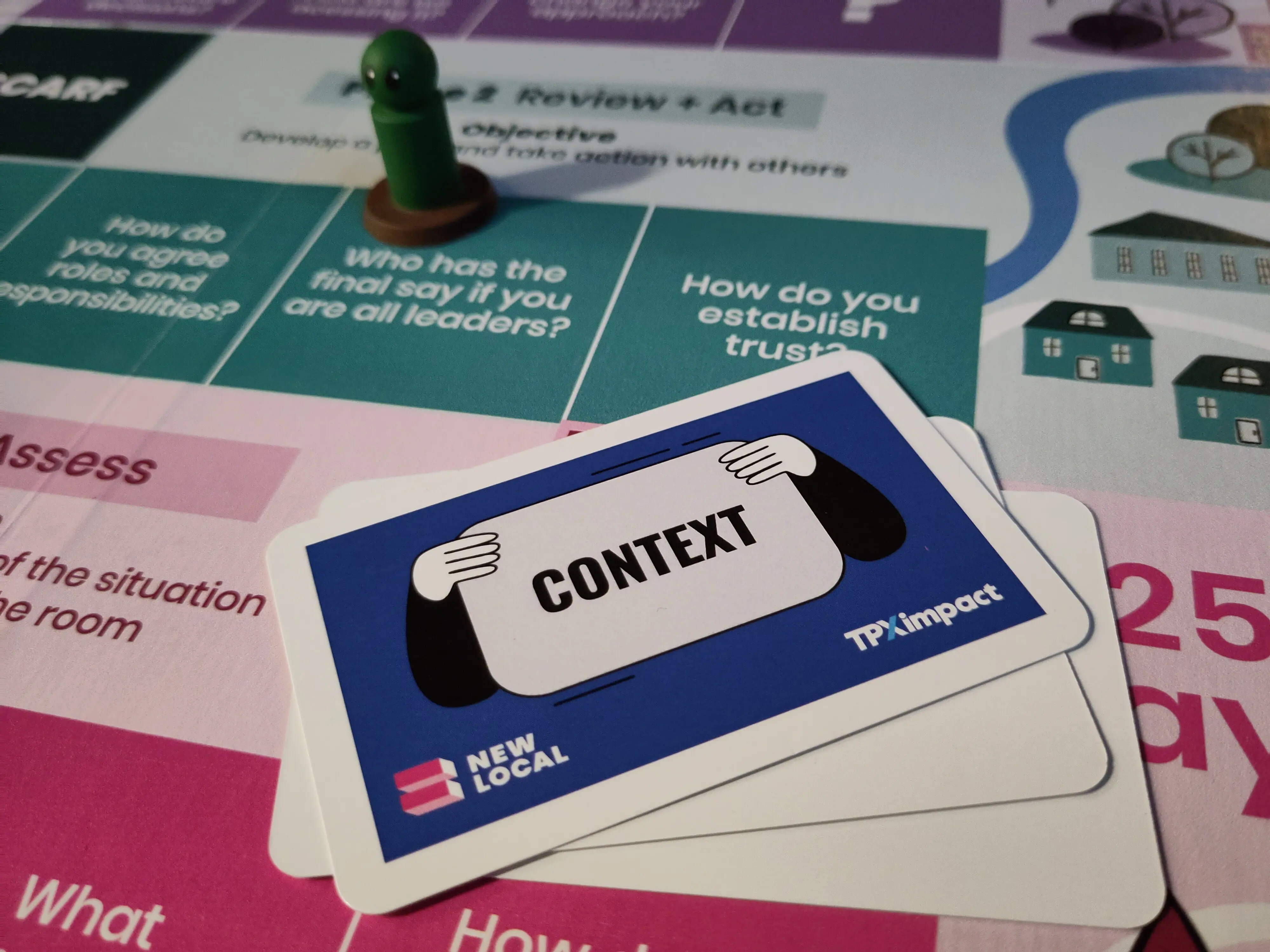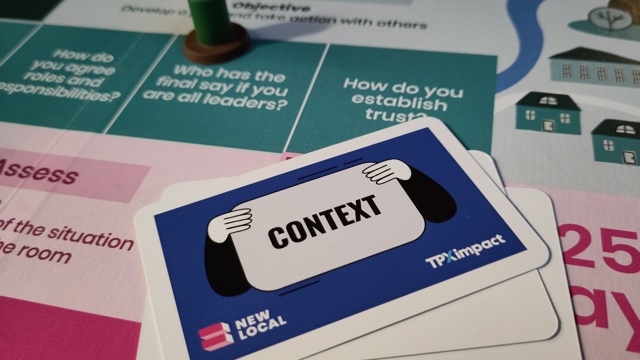In the early weeks of this year, I shared this article from Margaret Heffernan at the University of Bath, called “Prepare for Surprises” around TPXimpact leadership and with the wider team. Margaret's article is all about how we can work and think in new ways to plan for a complex and constantly changing world. Spoiler: it means flexibility, open-mindedness, responsiveness and curiosity.
When New Local asked me to join their first Next Generation Academy, it seemed like perfect reading to share with a group of future leaders.
We need to move away from the notion that we can forecast things in a complex world. Instead, we need to be much better at sensing and responding to the world as it changes around us.
I should confess up front that I don't believe a fully virtual council would be my ideal answer to this vision. But we should recognise how much more inclusive and accessible some services have become because they’re online. You don’t have to physically go to a council building to sign a form anymore. Virtual is a means, not an end to delivering better outcomes for communities.
The council as a platform
The pandemic forced us all to try new and virtual ways of delivering services, technologies and ways of operating. But also for many, we’ve been presented with a real opportunity to rapidly progress new approaches that would normally have taken years, if not decades, to introduce. All of which has resulted in more effective public services.
As leaders, it’s helpful to reflect on what a vision for a fully virtual council might look like, as we think about how our organisations, behaviours and mindsets need to change in this hybrid world. When imagining a fully virtual council, I found it useful to take a step back and reflect on a piece of work we did with Bristol Council a few years ago. To help them think about their vision for Bristol as a place, we imagined the council as a platform.
"A platform is a group of technologies that are used as a base upon which other applications, processes or technologies are developed. In personal computing, a platform is the basic hardware (computer) and software (operating system) on which applications can be run."Techopedia
A platform sets the rules by which different activities interact with each other. It dictates how they share information, the priorities and how things happen.
A good example is the iPhone and Apple App Store. By creating the rules, standards and permissions to connect hardware to software, Apple created a platform on which they can build endless applications from creative organisations. Platforms on their own don’t do very much, but they do create the conditions for other people to do lots of innovative things, easily.
We’re already used to thinking of councils as a platform for place-shaping with places that have a joined-up view of their planning rules and leadership. Imagine a council in a deprived area that wants to attract employers to the town; they’ve realised the need to have somewhere that business owners would want to live, so they prioritise the planning consent for executive housing, even though this doesn’t reflect their current market demand.
Thinking in this way about the council as a platform, it’s easy to imagine some of the quick wins that come with a fully virtual council. You’re probably already doing it, implementing better websites, bringing services online and even through the virtual council meetings that until very recently, were permitted.
But some councils are going further still, experimenting with bringing people together in virtual spaces to make change happen. Blackpool Council is bringing people together in virtual spaces through their first climate-focused citizen assembly. We’ve also been supporting Camden to begin digitising planning application notices; not only adapting due to Covid-19 restraints but taking action to encourage residents to have a voice in shaping the future of their place.
We’ve even begun to see investment in virtual reality tools with the 360 Virtual Tour of the TFL Elizabeth Line at Farringdon station. And South Northamptonshire are using virtual reality to support their shielding councillors to still be able to take part in committee meetings. And the use of chatbots is on the rise, with organisations like YouGov running conversations and resident surveys online, gathering opinions and feedback all through the use of artificial intelligence. Such tools are also being used to help residents find services and information online, reducing the amount of time spent waiting to talk to council staff directly.
What might virtual public services look and feel like?
The goal of any virtual council must be to enable radically better services for the public and do so in a way that makes it simpler and faster for officers, the private sector and nonprofits to meet people’s needs. This is how some of this might look:
- The council website becomes increasingly important as residents' first point of interaction with services. The site will need to serve as a digital platform for connecting people to data, information, contacts and services so more people can meet their own needs
- Online services will still need to be designed to meet the needs of all residents. The experience of feeling simple and joined up for residents (with a range of needs) will be the difference in reducing expensive telephone bills or excluding people with disabilities. Good content design is essential.
- Councils will need to provide definitive data. Some town and parish councils work to augment the core “ordnance survey” style maps with information about local assets that don’t get a mention on a Geographical Information System. The locations of park benches and their condition, the pitches for the farmers’ market, the calendar of events on the common and even the names on the headstones in the cemetery. These are all examples of “open data” that can be used by many different people and organisations.
- Common, easy to access and accurate online information about the nature of deprivation can help local charities with their grant applications. Information about the skills profile can attract employers and information about the wealth and shopping habits can attract relevant businesses. This isn’t about the council opening businesses, employing people or giving out grants, it’s about creating the conditions.
An example of this is Ride, a virtual platform we created with Suffolk and Essex County Councils, designed to allow people to book trips on demand through responsive transport in rural areas. Councils create the platform, allowing residents to signal their needs and connect them to regulated bus operators that respond flexibly on demand. The council provides the platform and data about trips and timetables but it doesn’t need to operate the service. Looking further into the future we also imagined how residents might also use the platform to provide trips to help each other.
How might the council as a platform work?
Councils will need to make the most of their networks and begin to see themselves as a wider network of assets, strengths and partnerships. We need to be comfortable with creating more virtual spaces for these officers and partners to come together from all different locations as we involve our communities in solving problems, together.
A focus must be on what new types of governance and skills are needed to manage conversations online with a more diverse range of partners and communities. If decisions are made in an assembly with residents, how do we stop them from getting caught up in the council’s machinery? With better organising structures between institutions and communities, we can harness the power and resources of institutions to better collaborate with communities and places, to achieve shared outcomes.
How leadership needs to adapt
A challenge is going to be creating new types of public services and leadership to make this work. Really successful local leadership could come from anywhere but won’t get very far unless the council is building the interconnections and a local vision for their place.
This can take many forms, most noticeably forging new relationships, partnerships and building alliances. These relationships must put purpose at their heart and make the most of the strengths of all organisations, so we can put the interests of our local communities first.
With this new vision also comes the need for new skills and abilities. Firstly, is the capacity to predict what will happen in future, which is difficult in a complex world. With this comes a need to react and respond to situations and problems as they arise, using different technologies available and helping colleagues do the same.
Now is the time to get comfortable with experimenting and taking risks. Planning three to four years ahead is impossible, we need to be comfortable adapting in much shorter periods of time.
Consolidating on the gains
In reality, our immediate future will involve some hybrid ways of working. Facilitation skills will become essential, not just in facilitating virtual meetings but also when new partners come together, and new types of conversation and debate in local places. Managing virtual teams also means spending more time checking in, bringing people together and focusing on mental health.
As leaders, we need to over communicate and do so in several ways. At the beginning of the pandemic, TPXimpact quickly launched an internal company bulletin, a virtual 30 minute weekly team meeting and additional virtual team standups. This year, we’re adapting those rhythms to suit our changing context and needs, and I’ve started writing “reflections”, aka week notes that happen roughly twice a month. We’ll continually reflect on these rhythms and adjust them as needed for our organisation.
The world will continue to get more complex. As we recover from the pandemic, councils that don’t consolidate on the gains learned and push forward with some of these changes risk leaving their communities behind.
It’s not just this period of Covid-19 and its complexity. The effects of climate change are already here and will only get worse. We must find ways of adapting and using some of the things we’ve learned over the last year from living virtually to solve them. This is an equal parts challenge and opportunity for all of us.

The role of play in building leadership skills
How play can offer local government leaders a powerful tool to break free from rigid structures.
Read moreOur recent insights
Transformation is for everyone. We love sharing our thoughts, approaches, learning and research all gained from the work we do.

The role of play in building leadership skills
How play can offer local government leaders a powerful tool to break free from rigid structures.
Read more
How we can transform local authorities for long-term success
What councils can do now to help address financial challenges now and in the future.
Read more
Creating the conditions for autonomy and decision making
Culture change can feel like an elusive ambition. We often feel the effects of it, and it can be an inhibitor when encouraging teams to adopt new processes and ways of working. One of the areas difficult to shift is the who and how around decisions.
Read more

